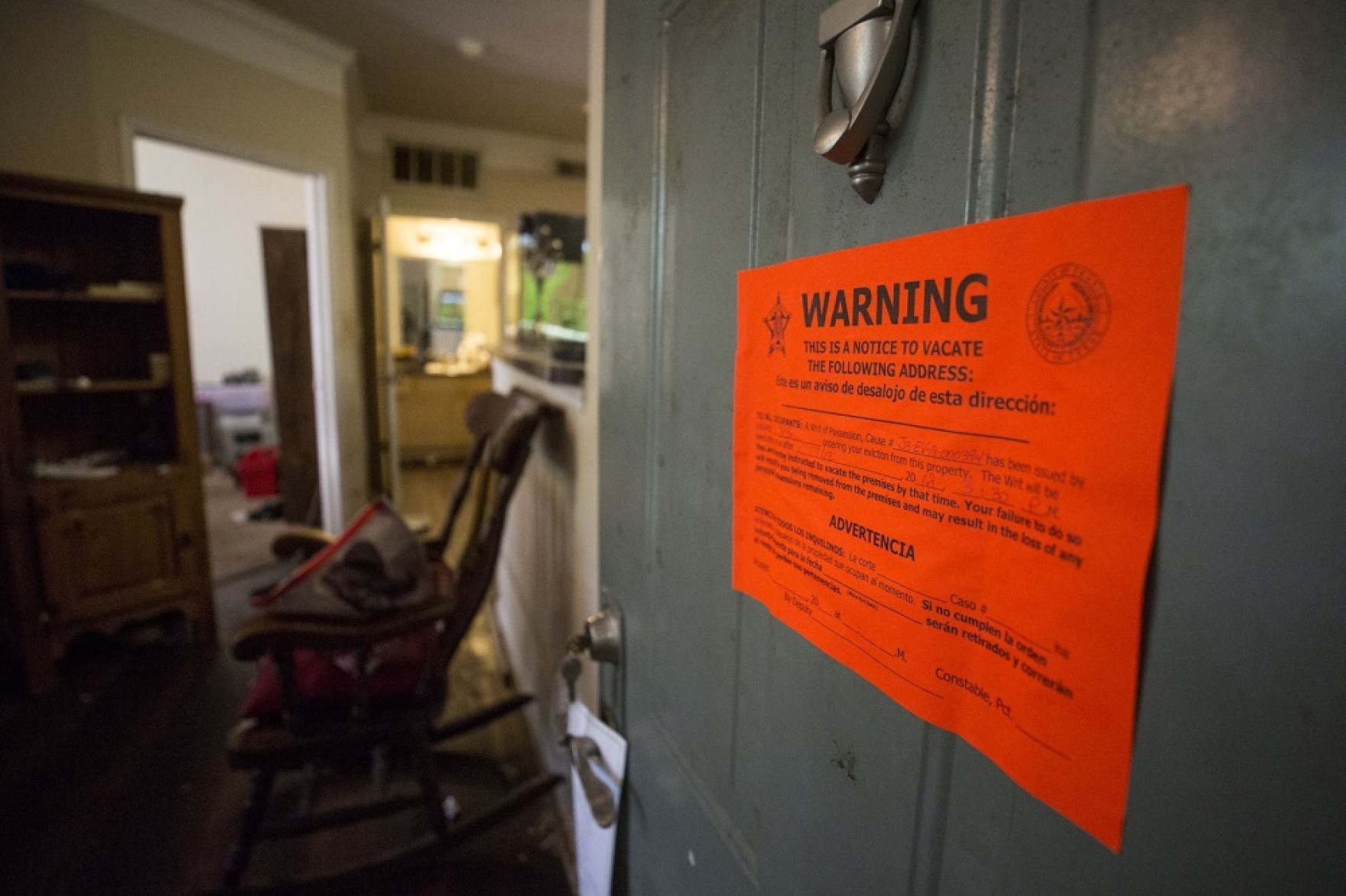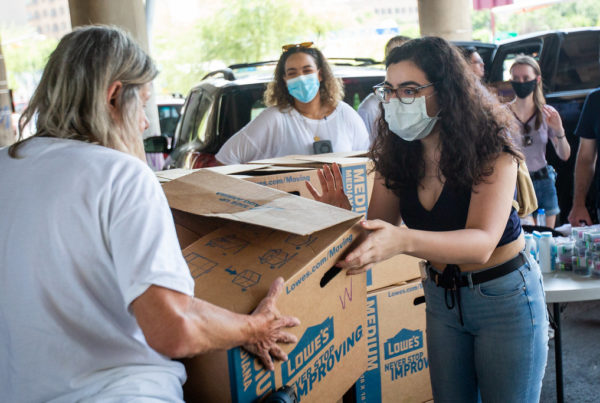From KERA:
When Congress passed the Coronavirus Aid, Relief and Economic Security (CARES) Act at the end of March, part of the goal was to help keep people in their homes as the nation battled a pandemic by trying to get people to stay home. A number of housing experts say that legislation, bolstered by state and local government measures, helped drive down evictions throughout the spring and summer as the nation’s economy saw record job losses.
Now, with the bulk of those protections mostly expired or reduced, 1 in 10 Texans are vulnerable to eviction in the coming months.
“I think we don’t have any idea what’s going to happen,” said Stuart Campbell, a Fort Worth-based housing attorney with Legal Aid of NorthWest Texas. “And that’s scary.”
The eviction moratorium included in the CARES Act only applied a portion of the nation’s rental units – the ones where landlords had federally backed mortgages or participated in subsidized housing programs — but Campbell says that plus a federal boost to unemployment checks, stimulus money and other aid kept a lot of the most vulnerable people from being evicted when they fell behind on rent because they lost work or got sick.
What the moratorium didn’t do: “It didn’t itself forgive a tenant’s contractual obligation to pay rent. They still owed that rent,” Campbell, who is based in Fort Worth, said.
By late July, more than a quarter of Americans had already missed a rent or mortgage payment and a third of renters weren’t sure if they could pay in August, according to the Census Bureau. When the moratorium ended on July 25th, landlords were free to start the eviction process in CARES Act-protected properties, starting a 30-day countdown that ended this week.
“The CARES Act was the dam, and instead of a Congress adding to it or keeping it up, they’ve decided to knock it down,” Campbell said. “And so that wave is coming.”
A Crisis Of ‘Epic Proportions’
Legal Aid of NorthWest Texas staffed up over the summer in anticipation of a deluge of eviction cases, adding 10 housing attorneys to its ranks and recruiting private attorneys to provide some free legal services to low- and middle-income people. Campbell still doubts that’s anywhere near enough for what’s coming.
The National Low Income Housing Coalition estimates that 30 to 40 million people in the US are vulnerable to eviction this year. Compare that to 2016, a fairly normal year with a relatively strong economy, when an estimated 2.3 million people were evicted, according to housing researcher Matthew Desmond. Even the Great Recession pales in comparison: Over six years, about 10 million people were foreclosed upon or evicted due to the economic fallout from the 2008 financial crisis.
“We’re on the precipice of a housing crisis of really epic proportions that rivals really the great depression, and that’s on top of a public health crisis,” said Lisa Alexander, a professor at Texas A&M School of Law who studies federal housing policy.
At the federal level, Democrats in Congress are trying to extend the federal eviction moratorium and funnel assistance to renters. Congressional Republicans have balked at their proposals. While President Donald Trump has supported extending the eviction ban, the executive order he signed on housing earlier this month didn’t actually do that. Instead, it directs some federal agencies to “consider” whether temporarily banning residential evictions might help fight the coronavirus.
“Right now, at the federal level, we’re kind of in limbo. There isn’t a federal eviction moratorium, so many people, if they aren’t living in a state or a county or a city that has enacted some kind of protection, they can be evicted now,” said Alexander.
That describes most Texans. Statewide protections here ended in May. Only Travis County has maintained a ban on evictions.
Austin and Dallas have rules in place that give renters time to get caught up with their landlords before eviction proceedings can be started (though Texas Attorney General Ken Paxton has questioned the legality of local eviction protections). Residents of other cities have little legal shielding if their landlord wants them out.
There is still some money in local rental assistance programs that was handed down by federal and state governments, but the money’s limited, can be hard to access, and has already run out in many places.
Meanwhile, pandemic stimulus checks have come and gone, and a $600-per-week boost to unemployment benefits has been cut in half for out-of-work Texans.
A Dip In Evictions
Those now-expired or reduced protections, plus landlords giving tenants a little more leeway, appears to have led to a major decline in eviction proceedings this summer. Though there is no centralized source for nationwide eviction data, Princeton University’s Eviction Lab found evictions in Houston were down 50 to 60%, and down 70% in Fort Worth compared to summer months in the last couple years.
Even so, Fort Worth has seen more than 2,000 eviction cases filed since the state ban ended in mid-May, and Houston, more than 6,400. In Austin, which is included under Travis County’s eviction moratorium, just 226 cases have been filed since mid-May to force renters out of their homes.
Ian Mattingly, who heads the Apartment Association of Greater Dallas, says landlords have also helped keep families housed as the pandemic drags on.
“I’ve seen members doing things that six or nine months ago would probably have been unthinkable as far as, payment reductions, deferrals, waiving late fees…even deferring evictions,” said Mattingly.
Mattingly also runs Lumacorp, which operates about 6,000 rental units in Texas. He says that, given the state of the economy, it’s the right business decision for many landlords to hold onto tenants who are actively communicating with them and trying to find a way to pay at least some of the rent.
But the knock on effects of an unchecked rental housing crisis could be vast, he warns. When tenants don’t pay rent, landlords can’t pay mortgages or employees. He wants to see Congress send more stimulus funding and other aid that’ll help struggling renters can make rent.
“Rental housing in the US is $1 trillion dollar a year industry,” Mattingly said. “Even if it’s only 15 or 20% of, of your residents who are not paying rent, I dare you to name an industry, in the world that can take a 20% reduction in income and not have effects throughout the entirety of the economy.”
Zoe Middleton, co-director of the low-income housing advocacy group Texas Housers says that the apparent dip in evictions over the summer doesn’t include tenants who were forced out of their homes by threat of eviction, even if landlords couldn’t legally follow through on the threat.
“They frequently feel like have to leave right when they see [a notice to vacate], which isn’t the case. You are not evicted until a judge says so, and you can also appeal that decision,” Middlton said. “But a lot of times people will just see that and use it as their cue to go.”
Pre-Existing Conditions
The new challenges of come on top of structural problems in the housing market that include a growing shortage of affordable housing, and a history of racist housing policy. The same historic and structural racism that produced disparities in health, wealth and income borne by people of color also left Black and Latino households less likely to be homeowners, more likely to pay too much for rent, and more vulnerable to evictions.
“What has happened is that COVID-19 has just exacerbated the problems that existed before,” said Alexander, the law professor.
Because market forces and government policies have failed to produce anywhere close to enough affordable housing, nearly half of all Texas renters — and 53% of Black renters – were considered rent-burdened before the pandemic hit. A study from the Harvard Joint Center on Housing found that, in 2018, more than one in five renters in Texas’ biggest cities were paying more than half their income in rent.
The numbers have been rising dramatically, as has the share of Texans who rent, rather than own, their homes.
The National Low Income Housing Coalition found Texas had less than a third of the affordable rental homes that were needed in 2018 to house the roughly 855,000 Texans at the lowest end of the income spectrum. Middleton, from Texas Housers, says the squeeze for those who need lower-cost market-rate rental homes will only be made worse by a spike in evictions.
“As people downsize and move into more affordable homes, the people who already live in that super affordable market-rate housing…those people are at greater risk for eviction, and so it’s really important that we stabilize that part of the market and those people for whom if they are evicted from that housing, there’s not a ton of options for where they can go,” Middleton said.
Middleton also worries that tenants are racking up credit card and other debt so they can pay rent and stay in their homes.
A ‘Traumatic Experience’
With all the talk about millions of looming evictions, Legal Aid lawyer Stuart Campbell says it’s easy to lose sight of what evictions do to individual families.
“It’s a very traumatic experience when a man with a gun and a badge shows up, after putting a red placard on your door, and says, ‘Either you leave, or I put you in cuffs and forcibly remove you from your home,’” and watch as movers drag all of a family’s possessions out onto the curb, Campbell says.
As things stand right now right now, that’s a trauma that experts say between 27 and 37% of all American renters could experience in the next few months.
















